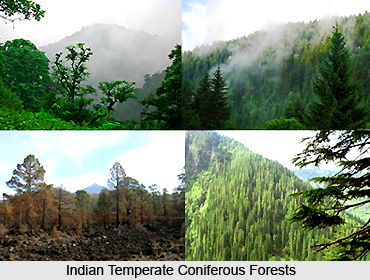 The Indian temperate coniferous forests are an integral part of the natural vegetation in India. These forests are actually a planetary major biotic community that is characterized by the dominant forms of plant life and the prevailing climate. The forests are mainly found in the temperate regions that have warm summers and cool winters and adequate rainfall to sustain a forest. The evergreen conifers are predominant in most of the temperate coniferous forests; however, a mix of conifers and broadleaf evergreen trees and/or broadleaf deciduous trees can be seen in some of the forests. The Temperate Coniferous Forests are actually a division of the Temperate Rain Forests that generally support an understory of mosses, ferns and some shrubs.
The Indian temperate coniferous forests are an integral part of the natural vegetation in India. These forests are actually a planetary major biotic community that is characterized by the dominant forms of plant life and the prevailing climate. The forests are mainly found in the temperate regions that have warm summers and cool winters and adequate rainfall to sustain a forest. The evergreen conifers are predominant in most of the temperate coniferous forests; however, a mix of conifers and broadleaf evergreen trees and/or broadleaf deciduous trees can be seen in some of the forests. The Temperate Coniferous Forests are actually a division of the Temperate Rain Forests that generally support an understory of mosses, ferns and some shrubs.
The Indian temperate coniferous forests are quite common in the coastal areas of the regions that have mild winters and heavy rainfall. They are also common in the inland in drier climates or mountain areas. The forests are home to several species of trees including Pine, Spruce, Cedar, Fir, Juniper, Cypress and Redwood. The understory of these forests also contains a wide variety of herbaceous and shrub species. The forests are simple and generally consist two layers like the overstory and understory. Some of these forests also support an intermediate layer of shrubs. The Pine forests that are included among the temperate coniferous forests support an herbaceous understory that is generally dominated by grasses and herbaceous perennials. They are also often subject to ecologically important wildfires.
The Indian temperate coniferous forests generally sustain the highest levels of biomass in any terrestrial ecosystem. They can be easily noticed for trees of massive proportions, including Giant sequoia, Coast Redwood, Douglas-Fir, Sitka Spruce, Alerce and Kauri. However, these forests are quite rare in India. The Indian temperate coniferous forests can be found in two eco-regions like the Eastern Himalayan sub-alpine conifer forests and the Western Himalayan sub-alpine conifer forests.



















